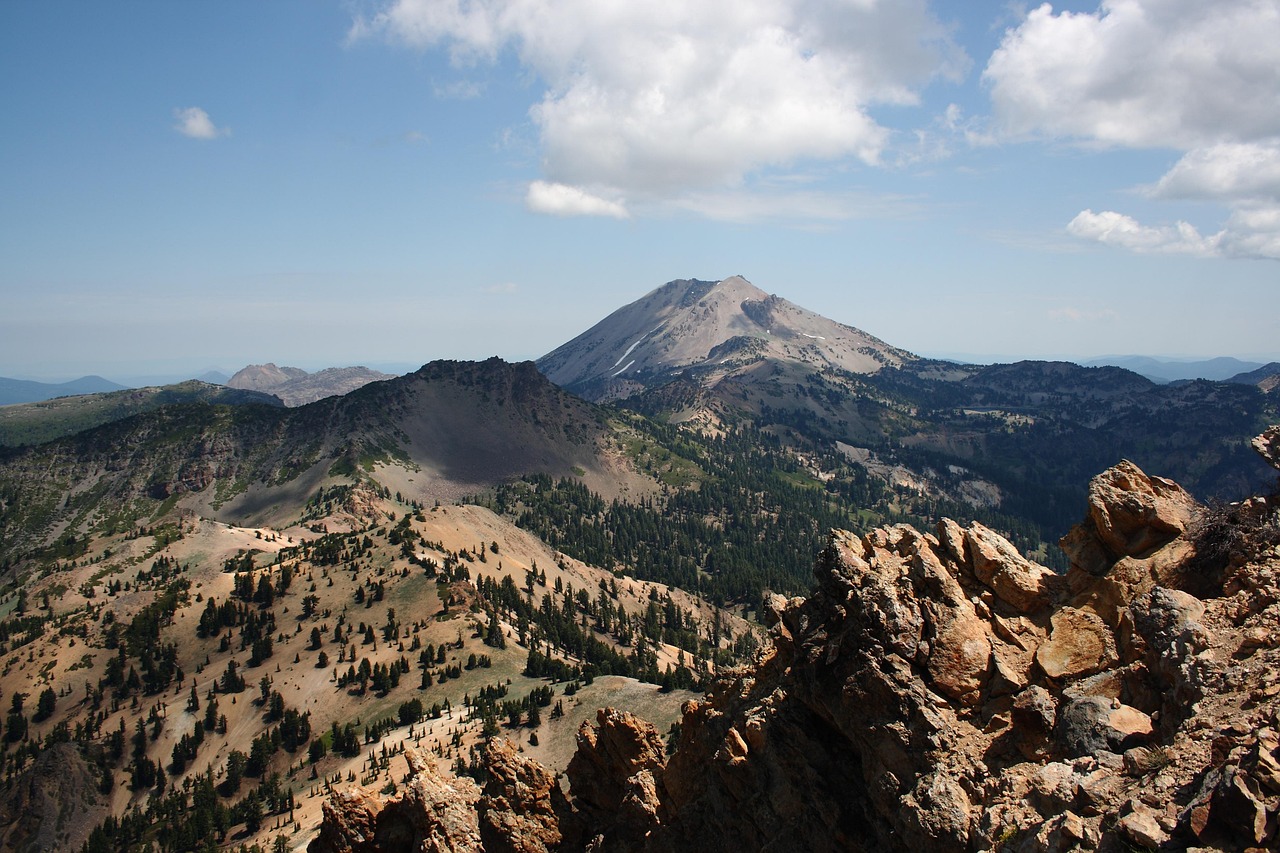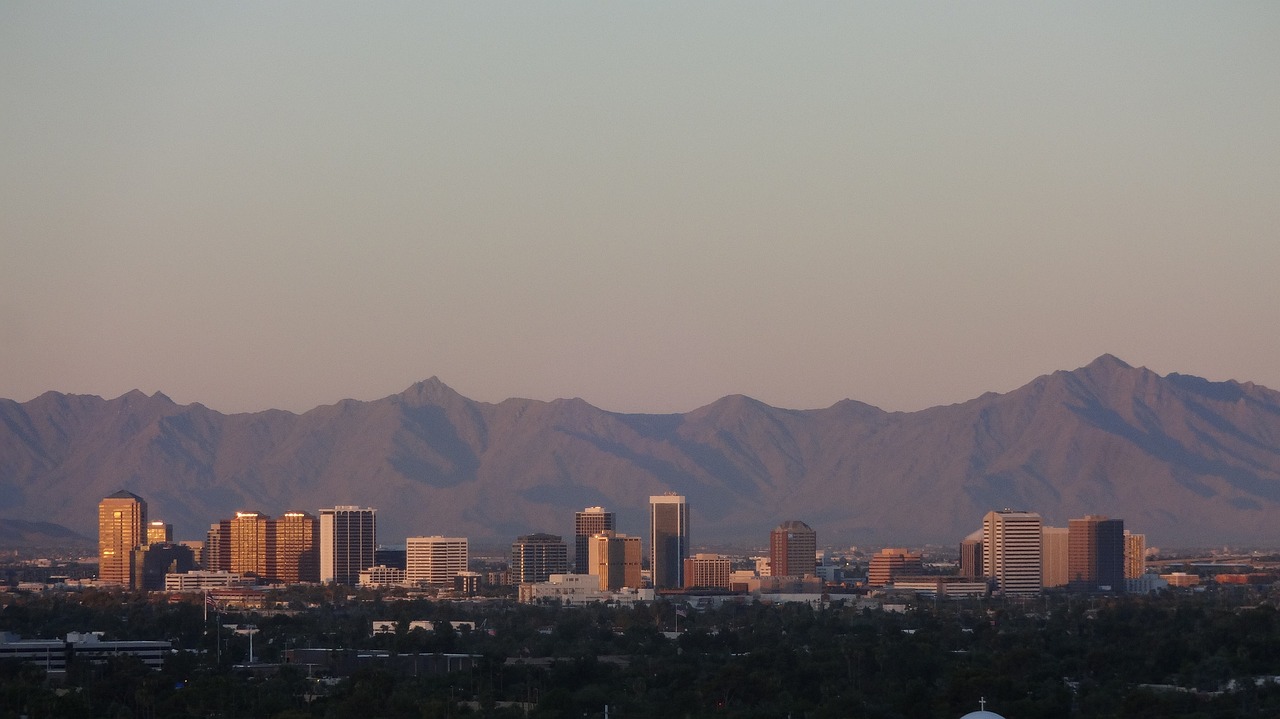
Looking for a unique vacation spot? Lassen Volcanic National Park is full of adventure. This guide shows what makes the park special, from volcanoes to clear lakes. Read on to discover more!
Key Takeaways
- Lassen Volcanic National Park is famous for Lassen Peak, a large plug dome volcano. It last erupted in 1915.
- The park has hydrothermal areas like Bumpass Hell with hot springs and mud pots. Visitors must stay on paths for safety.
- You can hike many trails in the park. Options range from easy walks to challenging climbs with great views.
- Camping and stargazing are popular activities. There are several campgrounds and clear skies for watching stars.
- Wildlife in the park includes black bears, deer, and over 200 bird species. Wildflowers bloom in its meadows during spring and summer.
Key Features of Lassen Volcanic National Park

Lassen Volcanic National Park boasts Lassen Peak, breathtaking volcanic domes, hydrothermal areas, and crystal-clear mountain lakes. It’s a natural wonderland filled with diverse landscapes that offer adventure seekers a variety of experiences.
Lassen Peak
Lassen Peak stands tall as the largest plug dome volcano in the world. It’s a big deal in Lassen Volcanic National Park, California. This volcano last erupted in 1915, which was quite a show.
Now, it’s peaceful and lets visitors hike to its summit.
The trail to the top is 5 miles round trip. Hikers get to see amazing views of other volcanic peaks from there. On a clear day, you can see far into the distance. It’s a must-see for anyone visiting the park.
Hydrothermal Areas
Hydrothermal areas in the park show how Earth’s heat shapes our world. Steam and boiling water come out of the ground at places like Bumpass Hell, a must-see spot. This area has hot springs, mud pots, and fumaroles – holes where steam shoots out.
You’ll smell sulfur, showing you’re near these features.
Walking on boardwalks, visitors see bubbling pools and steaming ground up close. It’s like another planet! Safety is key around these spots. Always stay on marked paths to enjoy the view without getting hurt.
Hydrothermal sites remind us that our planet is alive and changing.
Volcanic Domes
Moving from the steamy hydrothermal areas, we find ourselves among the park’s volcanic domes. These domes are mounds formed by lava that is too thick to flow far. Instead, it piles up right where it erupts.
The most famous of these is Lassen Peak itself, which last erupted in 1915. This was a big event and drew attention to the area.
Domes in the park show how Earth can really shape a landscape over time. Each dome has its own story, telling us about volcanic activity that goes back thousands of years. They add unique spots for visitors to see ancient lava rocks up close and personal.
Walking around these formations feels like stepping onto another planet, with rugged surfaces and sweeping views across the park.
Clear Mountain Lakes
Lassen Volcanic National Park is home to clear mountain lakes that are a sight to behold. These glacial lakes, including Lake Helen and Manzanita Lake, offer stunning crystal-clear waters reflecting the surrounding mountain landscapes.
Visitors can partake in various activities like fishing, kayaking, or simply enjoying a peaceful picnic by the tranquil shores of these pristine alpine lakes. The clarity of these mountain lakes is due to the absence of sediment and algae, providing an unobstructed view of the submerged features and aquatic life beneath their glistening surfaces.
The park’s clear mountain lakes are not only scenic but also play a vital role in maintaining the delicate ecosystem within Lassen Volcanic National Park. The pure water supports diverse flora and fauna, making it an essential habitat for various species while also offering visitors a chance to witness nature at its best.
Whether you’re seeking serene natural beauty or looking for outdoor adventures, these clear mountain lakes provide an idyllic setting for anyone looking to connect with nature.
Popular Activities
Explore numerous hiking trails showcasing stunning mountain landscapes, enjoy camping under the starry night sky, encounter diverse wildlife species and take in the breathtaking beauty of Lassen Volcanic National Park.
Learn more about other exciting activities by discovering our blog!
Hiking and Trails
Lassen Volcanic National Park offers a variety of hiking trails for all levels of hikers, from beginners to experienced trekkers. The park’s trails take you through diverse landscapes, from lush forests to volcanic features and clear mountain lakes. Here are some of the best hiking and trail options within the park:
- Lassen Peak Trail: A strenuous 5-mile round trip hike with rewarding panoramic views at the summit.
- Bumpass Hell Trail: An easy 3-mile round trip walk leading to an otherworldly hydrothermal area with bubbling mud pots and steaming vents.
- Cinder Cone Nature Trail: A moderate 4-mile round trip hike that takes you to the top of a cinder cone volcano for breathtaking views of the surrounding landscape.
- Kings Creek Falls Trail: An easy 2.8-mile round trip trail leading to a stunning 30-foot waterfall, surrounded by lush greenery.
- Manzanita Lake Trail: An easy 1.5-mile loop around the picturesque Manzanita Lake, offering serene views and wildlife spotting opportunities.
Each trail offers a unique perspective on the park’s natural beauty, making it an ideal destination for hiking enthusiasts seeking adventure and exploration in a volcanic wonderland.
Camping and RV Sites
Lassen Volcanic National Park offers various camping and RV sites for visitors to enjoy the wilderness. Here are some options:
- Manzanita Lake Campground: Situated near the northwest entrance, it provides easy access to Lassen Peak and offers stunning views of the lake and surrounding landscapes.
- Summit Lake Campground: Located in a picturesque setting with nearby hiking trails, this campground is popular for its serene atmosphere and access to clear mountain lakes.
- Southwest Walk-in Campsites: For a more secluded experience, these walk-in sites offer a primitive camping experience amidst lush meadows and volcanic landscapes.
- Butte Lake Campground: Nestled in a scenic area abundant with lava rocks and the Fantastic Lava Beds, this campground is ideal for those seeking an off-the-beaten-path adventure.
- Juniper Lake Campground: With its peaceful surroundings and proximity to the Pacific Crest Trail, this campground is perfect for hikers and nature enthusiasts seeking tranquility.
This variety of camping options allows visitors to immerse themselves in the natural beauty and diverse landscapes of Lassen Volcanic National Park. Whether you prefer lakeside views or secluded spots surrounded by volcanic features, there’s something for every camping enthusiast at this spectacular destination.
Stargazing Opportunities
Stargazing at Lassen Volcanic National Park is a mesmerizing experience due to its dark skies, perfect for seeing stars. The park is designated as a “Dark Sky Park,” meaning there’s minimal light pollution, making it an excellent spot for observing celestial bodies.
On clear nights, visitors can witness numerous constellations and even the Milky Way with the naked eye. During meteor showers, such as the Perseids in August, you can see shooting stars streaking across the sky.
The park regularly hosts stargazing events led by knowledgeable astronomers who provide telescopes for an up-close view of planets and distant galaxies. Additionally, bring binoculars for an enhanced stargazing adventure.
Remember to check the park’s event schedule for special astronomy programs and plan your visit during new moon phases when the night sky is at its darkest. After a fulfilling day of exploring Lassen’s wonders, unwinding under the starry night offers an unforgettable conclusion to your adventures.
Wildlife Observation
Lassen Volcanic National Park is a haven for wildlife enthusiasts. The park is home to a diverse range of animals, including black bears, mule deer, and coyotes. Birdwatchers can spot over 200 species of birds, from colorful warblers to majestic bald eagles.
Visitors may also encounter smaller mammals such as squirrels and chipmunks scurrying amidst the lush forests and meadows.
The park’s vast wilderness provides ample opportunities for observing wildlife in their natural habitats. Keep an eye out for these fascinating creatures while exploring the park’s trails or simply enjoying a peaceful picnic by one of its clear mountain lakes.
Geology of the Park
The park’s geology reveals fascinating insights into the formation of its volcanic domes and hydrothermal processes, shaping its remarkable landscape. Exploring Lassen Volcanic National Park’s geological features promises a deeper understanding of its unique natural formations and phenomena.
Formation of Volcanic Domes
Millions of years ago, the Lassen Volcanic National Park was shaped by incredible forces. The park’s volcanic domes were formed through the eruption of lava, ash, and rock fragments.
These fiery eruptions built up layers upon layers of hardened magma over time, creating the distinctive dome-shaped structures that are visible today. At Lassen Volcanic National Park, you can witness these unique formations up close and marvel at the powerful geological processes that shaped them.
As you explore the park’s trails, keep an eye out for these impressive volcanic domes that stand as a testament to the earth’s extraordinary natural history. Whether it’s from afar or up close on a hike, experiencing these ancient formations is a captivating journey through time and nature.
Next on our adventure is learning about Hydrothermal Processes in this remarkable national park!
Hydrothermal Processes
Lassen Volcanic National Park features captivating hydrothermal areas, showcasing the park’s geothermal wonders. Bumpass Hell offers a glimpse of boiling mud pots and steaming fumaroles, while Sulphur Works presents the sight of colorful mineral deposits and hissing steam vents.
These unique natural phenomena provide a fascinating insight into the region’s volcanic activity and offer visitors an up-close encounter with the earth’s raw power. The park is home to these captivating hydrothermal features that add to its diverse geological landscape, making it an intriguing destination for nature enthusiasts.
The hydrothermal processes at Lassen Volcanic National Park are a striking reminder of the powerful forces shaping our planet. Bursting with vibrant colors and bubbling hot springs, they form part of an exceptional experience for travelers seeking to witness nature’s incredible diversity firsthand.
Flora and Fauna
The park is filled with meadows blooming with wildflowers, bringing vibrant colors to the landscape. The rich biodiversity includes various native wildlife species like deer, bears, and a variety of bird species.
Meadows and Wildflowers
In Lassen Volcanic National Park, the meadows and wildflowers are a stunning sight to behold. The park is home to around 250 types of wildflowers that bloom from spring through summer, creating vibrant displays of color across the park’s meadows and mountain slopes.
Some common wildflower species include lupine, paintbrush, larkspur, and corn lilies. These beautiful blooms attract a variety of butterflies and bees, adding to the natural tapestry of sights in the park.
The lush meadows provide crucial habitat for many animals in the park, including deer and other grazing wildlife. Visitors can enjoy leisurely walks or hikes through these peaceful settings while taking in picturesque views of blooming wildflowers against the backdrop of rugged volcanic landscapes.
Additionally, an array of bird species can be spotted flitting among the flowers and grasses, making it a paradise for nature enthusiasts and photographers alike.
Native Wildlife Species
Lassen Volcanic National Park is home to diverse wildlife, including black bears, mule deer, and pumas. Birdwatchers can spot over 200 species of birds such as the northern goshawk and western tanager.
The park’s meadows are filled with wildflowers attracting butterflies and hummingbirds.
These animals have adapted to the harsh volcanic landscape, creating a unique ecosystem. Visitors can observe these creatures in their natural habitat while exploring the park’s trails or camping alongside them.
Next up is “Planning Your Visit” where we’ll cover everything you need to know before your trip!
Planning Your Visit
Plan your visit easily with clear directions and access information. Discover the best times to explore this natural wonder and nearby attractions to complete your experience.
Directions and Access
Lassen Volcanic National Park is situated in northeastern California. The main entrance to the park, Manzanita Lake Entrance, can be reached via State Route 44. This route provides access to various key features like Lassen Peak and the scenic Devastated Area.
Other entrances include Butte Lake, Southwest Entrance, and Northwest Entrance, each offering unique experiences within the park. During winter months (approximately mid-October through late June), some areas of the park may be inaccessible due to heavy snowfall, so it’s important to check for road closures before planning your visit.
For those traveling by air, Redding Municipal Airport is the closest airport to the national park and offers car rental services for added convenience. Once inside the park, a self-guiding auto tour showcases many points of interest while providing easy access for travelers of all ages and abilities to enjoy this geothermal wonderland.
Best Times to Visit
When planning a trip to Lassen Volcanic National Park, it’s essential to consider the best times to visit. The park is generally open year-round, but the main road through the park is closed from late October or November until June due to heavy snowfall.
Therefore, the most popular time to visit is during the summer months when all areas of the park are accessible. July and August are ideal for hiking and exploring without encountering much snow.
However, if you prefer fewer crowds and cooler temperatures, early fall (September and October) can be a great time to experience vibrant foliage and catch stunning views with fewer visitors.
The best times for wildlife observation are during spring and early summer as animals become more active after winter hibernation. Additionally, wildflower enthusiasts will find mid-July to mid-August prime for witnessing colorful blooms throughout the meadows at higher elevations such as Bumpass Hell Trail or Kings Creek Falls area.
Keep in mind that weather conditions can change rapidly at high altitudes so it’s crucial to check forecasts before heading out on any adventure within the park.
Nearby Attractions
After exploring the natural wonders of Lassen Volcanic National Park, you can venture to nearby attractions like Lake Almanor and Mount Shasta. Lake Almanor, just an hour’s drive away, offers opportunities for swimming, boating, and fishing with its 52 miles of shoreline.
Mount Shasta is a majestic peak that stands over 14,000 feet tall and beckons adventurers with its hiking trails and mesmerizing views. These neighboring destinations provide diverse experiences for nature enthusiasts looking to extend their outdoor adventures beyond Lassen Volcanic National Park.
These additional sites offer alternative terrains and activities such as water-based fun at Lake Almanor or challenging hikes amidst stunning landscapes at Mount Shasta – ensuring there’s something for everyone in this wondrous corner of California.
Conclusion
Lassen Volcanic National Park offers a stunning mix of volcanic landscapes and natural beauty. Visitors can explore Lassen Peak, vibrant hydrothermal areas, and clear mountain lakes throughout the park.
The park provides ample opportunities for hiking, camping, stargazing, and observing wildlife in its pristine wilderness setting.
In addition to its fascinating geology and diverse flora and fauna, Lassen Volcanic National Park is an unparalleled destination for outdoor enthusiasts. With its unique blend of volcanic activity, glacial lakes, bubbling mud pots, and sweeping mountain vistas, it truly embodies the spirit of adventure.
Whether you’re drawn to exploring the park’s geological wonders or simply seeking a tranquil retreat in nature’s embrace, Lassen Volcanic National Park promises an unforgettable experience that celebrates California’s natural heritage.
FAQs
1. What is Lassen Volcanic National Park?
Lassen Volcanic National Park is a beautiful place in California. It features active volcanoes, hot springs, and stunning landscapes. Visitors can explore its unique geology and enjoy outdoor activities like hiking.
2. What can I see at Lassen Volcanic National Park?
You can see many things at Lassen, including bubbling mud pots, steaming fumaroles, and colorful mineral deposits. The park also has lovely lakes and forests that are perfect for wildlife watching.
3. How do I get to Lassen Volcanic National Park?
To reach the park, you can drive from nearby cities like Redding or Susanville. The roads are well-marked, making it easy to find your way to this natural wonder.
4. When is the best time to visit Lassen Volcanic National Park?
The best time to visit is during the summer months when trails are open and accessible. However, spring brings wildflowers while fall offers beautiful foliage; each season showcases something special!







Leave a Reply